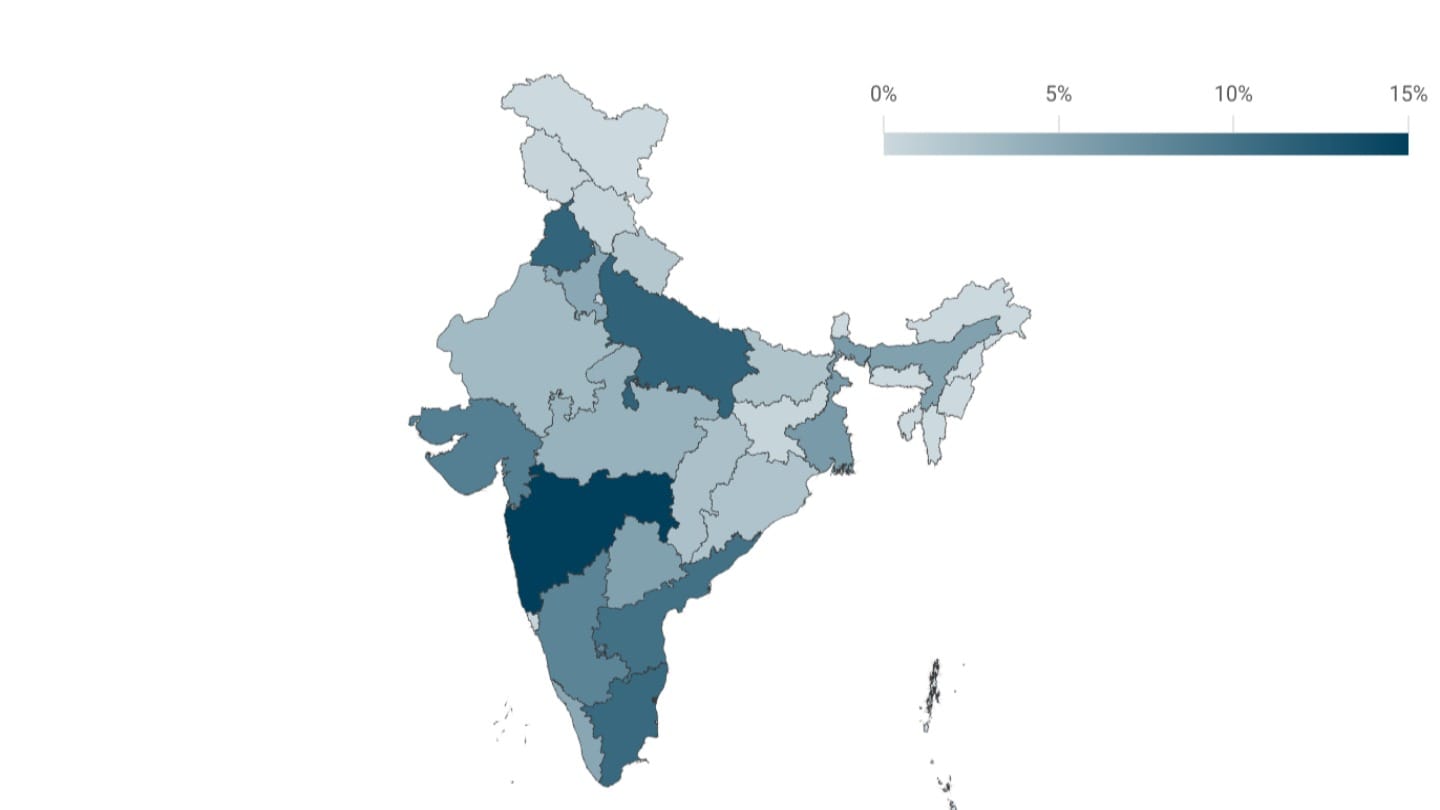Unorganised manufacturing
Most of India's manufacturing workforce is in the unorganised sector, working in small, family-run units. In this piece we look at the size and scale of unorganised manufacturing in the country, what these units make and whom they employ.
Manufacturing activity in India takes place in two broad ways: organised manufacturing that happens in factories, and unorganised manufacturing that is typically at a small scale and family-run.
The majority of India's manufacturing workforce is in the unorganised sector[1], although unorganised manufacturing contributes only 12% of the gross value added (GVA) in manufacturing.[2]
What is unorganised manufacturing?
In Indian statistics, an 'unincorporated establishment' is a household proprietary or partnership establishment that is not registered under India's Companies Act. Such unregistered household units that carry out manufacturing activities are defined as unorganised manufacturing enterprises.[3] Data on these enterprises comes from the Annual Survey of Unincorporated Sector Enterprises (ASUSE).[4]
There were 74 million unorganised establishments in India in 2024, out of which, 20 million were in unorganised manufacturing, while the rest were in the services sector. There are far more unorganised than organised manufacturing units in India. In comparison, there are only about 200,000 operational factories.
Most unorganised manufacturing enterprises are small in size
Nearly two-thirds of unorganised manufacturing establishments, or a little more than 12 million, are in rural areas.
Most of the establishments in unorganised manufacturing are run by a single person. More than four in five establishments (a little less than 18 million) are own-account establishments. In own-account establishments, only one person (the owner) gets financial remuneration from the activity, but they may have assisting family members who do not get paid (unpaid family helpers).
Only one in five (less than three million) unorganised manufacturing enterprises are hired worker establishments, meaning that apart from the owner, there is at least one worker who has been hired and gets a remuneration.
These unorganised manufacturing units employ 34 million people in all.[5] The majority of them are the owners of their own single-person establishments, while another nine million are hired workers, and four million are unpaid family helpers.
While most unorganised manufacturing units are small, over 5.5 million establishments have more than five workers, while more than 3.5 million have more than ten workers.
Most unorganised manufacturing establishments in India are run from within the owner's own house. About a quarter of unorganised manufacturing units are operated outside the house from permanent structures, while a small proportion of such establishments operate without any fixed location.
These small enterprises operate in distinctly informal ways.
Two-thirds of the enterprises maintain a bank account, but most bank accounts are registered in the name of the owner rather than that of the establishment. Less than 1% of the establishments maintain their financial accounts such as balance sheets and profit and loss accounts. Only 1-2% use the computer.[6] Less than 2% of unorganised manufacturing establishments are registered under the Goods and Services Tax (GST) legislation.
Women in unorganised manufacturing
Among the 34 million people employed in unorganised manufacturing, 18 million are men, and a little less than 16 million are women. However in rural areas, the majority of those in unorganised manufacturing are women.
Most women in unorganised manufacturing (12 million) run their own single-person enterprises with no other workers. A little less than 2.5 million are unpaid workers in enterprises run by their family members. Another 1.5 million work as paid hired workers in enterprises owned by others.
The work arrangements of male unorganised manufacturing workers are more diverse. While male workers are more likely to be the proprietors of their own unorganised manufacturing enterprises, there are also nearly as many male workers (about 7 million) who are hired workers in establishments owned by others.
While unorganised manufacturing enterprises that hire workers are in a minority, most of the establishments who have hired workers are owned by men. The one million women hired workers are also employed in establishments run by men.
What do unorganised manufacturing units make?
Three quarters of unorganised manufacturing enterprises in India are in four industries alone - textiles, apparel, food, and tobacco product manufacturing. Nearly half are in apparel manufacture alone.
These industries also employ most unorganised manufacturing workers. Half of India's unorganised manufacturing employment is in three industries alone: apparel, textiles and tobacco products.
Where does most unorganised manufacturing take place?
West Bengal, Uttar Pradesh, Maharashtra, Gujarat and Tamil Nadu accounted for half of India's unorganised manufacturing enterprises.
West Bengal has a relatively low presence of organised manufacturing (tenth among states in terms of operational factories) but has the most unregistered manufacturing enterprises in the country. Most of these units are single-person enterprises.
Many of these workers are in the tobacco industry; half of India's unorganised manufacturing enterprises engaged in the making of tobacco products are in West Bengal. About one million hand-rolled cigarette makers work in the state.[7]
[1] India's statistical system measures manufacturing employment in two ways - by surveying enterprises and by surveying households. In the former method, it estimates that unorganised manufacturing covers nearly 60% of manufacturing employment (30 million in ASUSE 2023), while factories (organised manufacturing) cover 40% (19 million in ASI 2023). The latter method is based on PLFS, and it estimates that unorganised manufacturing employs about 75% of India's total manufacturing workforce. Read more about the differences in measurement here.
The ASI, ASUSE and PLFS define manufacturing in slightly different ways from each other.
[2] In India's National Accounts Statistics, the share of unincorporated manufacturing enterprises in the gross value added in manufacturing was 12% in 2023-24 at current prices. It has remained between 12% and 14% for more than a decade.
[3] Annual report of the Annual Survey of Unincorporated Sector Enterprises, 2023-24.
[4] In the manufacturing sector, ASUSE covers (1) Manufacturing establishments excluding those registered under Sections 2(m)(i) and 2(m)(ii) of the Factories Act, 1948, (2) Manufacturing establishments registered under Section 85 of Factories Act, 1948, (3) Establishments engaged in cotton ginning, cleaning and bailing (code 01632 of NIC- 2008) excluding those registered under Factories Act, 1948, (4) Establishments manufacturing bidi and cigar excluding those registered under Bidi and Cigar Workers (Conditions of Employment) Act, 1966.
[5] To calculate absolute numbers, we use population estimates from the Census Population Projections 2011-2036 based on the 2011 Census.
[6] ASUSE records if the establishment had used a computer and the internet during the 365 days preceding the survey.
[7] Manufacture of "bidi" or hand-rolled cigarettes is featured in the 5-digit NIC Sub-class 12002 under the 2-digit NIC division 12 that covers tobacco products.




